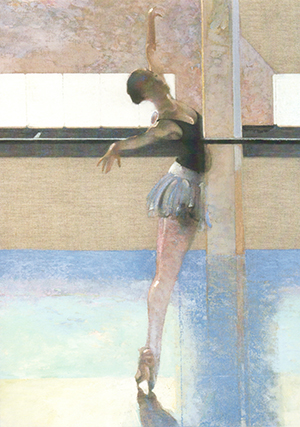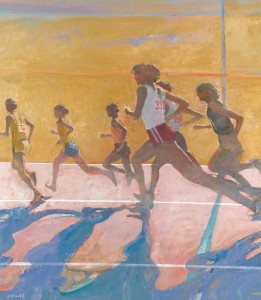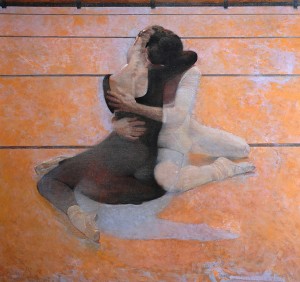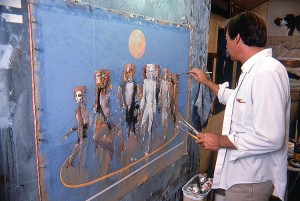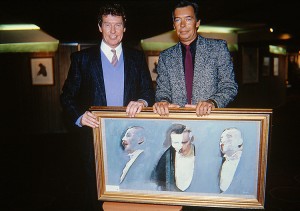The work of Robert Heindel is now synonymous with the world of dance, classic and contemporary ballet in particular. Even today, several years after the artist’s life, the images he created are frequently more recognisable than the name; for an artist who devoted more than twenty five years in the pursuit of dance in its many forms this visual recognition reflects his success.
Born 1938 in Toledo, Ohio, drawing and painting were a natural talent that he instinctively knew to pursue. At the age of 16 he enrolled in The Famous Artists School, eventually to become one of its most celebrated graduates. Whilst following the FAS course by correspondence, like many young artists, he found work in art studios including that as a staff artist at Coen & Foger in Toledo. Those early studio experiences combined the discipline required to maintain the FAS course proved a valuable training for what became a highly successful career in commercial illustration and later working to exhibition schedules for fine art galleries around the world.
His career in the world of illustration took him from Toledo to Akron, Denver, Detroit and eventually to be represented by one of the top agencies in New York. His work was seen across America in leading magazines such a TIME and Sports Illustrated which in turn increased the demand and awareness of R.Heindel. He won several prizes during this period of his career including, in 1982, The Hamilton King Award from The Society of Illustrators (New York); in 2011 he was posthumously inducted into the society’s Hall of Fame for ‘distinguished achievement in the art of illustration’. Work from this period also gained a place in the collection of The Smithsonian Institute, Washington D.C.
Robert married Rosalie Petres in 1959 and together they had three sons, Toby, Troy and Todd. Rose often modelled for both advertising assignments as well as for early fine art works destined for galleries. Whilst they moved quite a lot in the early years of their marriage, in the early 1970’s they moved to an old farmhouse set in several acres of woodland in Connecticut. The house with its warm character and spirit was to remain their home for thirty years and from within the vast majority of his dance works were created. In his later years Heindel moved, with Rose, to town of Guilford. There he continued to paint and explore his love of dance until his death in 2005.
One evening in Detroit, Robert and Rose had accepted tickets to see the ballet. Initially reluctant, Rose persuaded her husband that the whole experience would be worth it….the rest is history! On stage that evening Rudolf Nureyev and Margot Fonteyn performed ‘Paradise Lost’ and with that an obsession for dance was kindled. As he commented at the time ‘why have I not been aware of this before in my life’? What was to follow was an output of over two thousand paintings, drawings and sketches which, although rooted in dance, served to express his emotions, experiences and vision.
The new found passion, for that is what it was, set the artist on a course that would eventually encompass US, Europe and Japan seeking dance and dancers that would serve to inspire him. At first he sought invitations and permission to work with several North American companies, these included Dallas Ballet, Cincinnati Ballet, San Francisco Ballet and Houston Ballet. The paintings and sketches which were developed from each of these encounters would generally form the core of exhibitions, usually staged in association with the respective companies in their home cities. The early blueprint of observation, painting and exhibition became a defining formula for many of the following years.

Robert Heindel taking photos of rehearsals at the Cincinnati Ballet for studies that would ultimately become “Romeo & Juliet”
Heindel had seen, been part of, the glamorous world of the New York advertising scene but knew times were changing with the advance in technology it was clear to him that the concept of advertisements being drafted by hand, altered, redrawn and so on would eventually be replaced by an altogether faster process. Added to this, he had experienced the gallery world by virtue of his first forays into dance. For him the lure of exhibiting his passionate work in high profile international venues took hold and thus he sought introductions to exhibit, first to London….
In 1983 he was introduced to the partners of a London based gallery, their connections in the ballet world were strong and thus doors were opened.. The Royal Ballet in Covent Garden, Rambert Dance Company, London City Ballet and London Festival Ballet (later English National Ballet). Thus in 1985 one of the artist’s greatest ambitions was realised, that of staging a one-man exhibition in London. ‘The Obsession of Dance’ presented in The Royal Festival Hall and opened by H.R.H Princess Margaret – Countess of Snowden, comprised a mix of 140 paintings, colour studies and sketches. Heindel had certainly immersed himself in that new found focus from which many of the familiar names in British ballet found themselves represented on canvas; Sir Frederick Ashton, Monica Mason, Marguerite Porter, Merle Park, Anthony Dowell and Wayne Eagling – therein the then current artistic director of The Royal Ballet (Sir Frederick Ashton) and two future holders of that prized position.
Of particular significance was a spirited oil of Sir Frederick Ashton which was painted to celebrate the choreographers eightieth year – the painting ‘Sir Fred’ is now in the collection of The National Portrait Gallery, London.
‘Sometimes, during the weary hours of rehearsal, the last thing a dancer needs is an intruder with a sketch book or camera recording all the trials and secret worries that we all have whilst trying to accomplish the impossible. Robert Heindel, apart from being one of the most courteous and charming of men, manages to camouflage himself into the studio setting, somehow hiding his ‘spying’ eyes. Many silent photos later, and after the magic process has taken place in his studio, one is presented with not only a true image of oneself but with a beautiful study and record of the private moments that one thought had been hidden.’
Sir Anthony Dowell
(Director, Royal Ballet. 1986 – 2001)

Anthony’s World – See Offset Lithographic Editions
Amongst Heindel’s audience at The Royal Festival Hall was Andrew Lloyd Webber. The composer’s enthusiasm for the collection prompted a request for Heindel to observe and paint what was the already well established musical, ‘CATS’. Allied to this was an invitation to observe the rehearsal period for what was to become a worldwide theatrical phenomenon, ‘The Phantom of The Opera’. ‘CATS’ provided the artist with opportunity to capture dance and movement in his inimitable style with such paintings as ‘The Jellicle Ball’ and ‘Victoria, The White Cat’. ‘Phantom’ was an altogether different proposition – almost pure musical theatre. For Heindel that was the challenge, to apprehend the spirit of ‘The Phantom’. The resulting series of sketches and paintings focussed almost wholly upon the two main characters, Sarah Brightman in the role of Christine and Michael Crawford in that of The Phantom. The complete collection, twelve months work, was exhibited in The New London Theatre in the spring of 1987.
‘As a performer and one who is very aware of the toil that goes into a production before curtain up, I am confounded by the emotions that Robert’s sketches and paintings of The Phantom stir in me. When I look at them I am transported to an exact moment in time that I can recall so clearly. The sketches are very immediate; perhaps that is why they are so telling. The paintings are certainly theatrical, conveying as they do, atmosphere and presence – they are performances in themselves.’
Michael Crawford – Actor
With the Lloyd Webber project complete, the artist had decided to return to the world of ballet, as fortune had it he had received an invitation from Monte Carlo Ballet. After several trips to The Principality the completed works were displayed in the salons of The Hotel de Paris where in December 1987 Princess Caroline opened the exhibition ‘L’Obsession de la Danse’. Two of the artist’s signature paintings formed part of that collection; ‘The Illumination’ captured a dancer in black against a black back drop, a beam of light touching her head and shoulders in dramatic style. The second painting entitled ‘The Wall’ featured five dancers at the practice barre, isolated as individuals but part of one harmonious image. Ironically neither painting sold in Monte Carlo and yet within a few months they were and in time have become amongst the most recognised and reproduced.
Autumn 1988 heralded the artist’s second major exhibition at The Royal Festival Hall in London. For this project he had chosen to develop a series or works from a one act ballet ‘The Garden of Eros’ performed by London City Ballet. Heindel was instrumental in the commissioning of the ballet itself, his friend and former Royal Ballet principal Marguerite Porter choreographed the piece. The venture gave him the facility to see a ballet created from concept to first night. Patron of London City Ballet at that time was Diana, Princess of Wales who was the artist’s distinguished guest at The Royal Festival Hall.
‘Experts hold your work in the highest regards, I know, but for me it simply succeeds in capturing the spirit of dance as art’
Diana, Princess of Wales
In 1990 as part of Glasgow’s EuropeanCity of Culture celebrations the Scottish Ballet asked Heindel to observe and record their company, in hindsight the collection represented a new focus and one that was the most personal of outpourings onto the canvas. With the success of his figurative works to that period, Heindel was eager to explore ‘beyond’ the pure human form whilst still in retaining a dance link. In the few months before embarking upon his ‘Scottish Shadows’ series (Scottish Ballet inspired work) he had experimented with paintings entitled ‘Floormarks’. In those paintings, around twenty in total, he examined, recorded and built upon observations of actual dance floors. For him the wooden boards held a history of all dance and rehearsal that had occurred upon them. The scuffs and scrapes, tape marks and lines were elevated to a finished art form, a painting that at first appeared abstract but for the explanation. With the experience of the ‘Floormarks’ fresh he used such devices to give the following dance paintings more depth and, in part, abstraction.
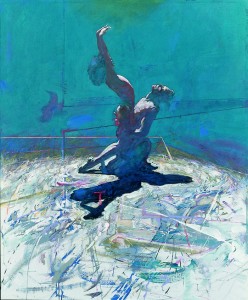
WAITING FOR THE MESSIAH I – See Silkscreen Editions
Added to this he started to dwell upon the dancers shadow cast by spotlight onto the floor before them and thus many of the Scottish Ballet works are dominated by strong, dark forms that stretch across the canvases. A disturbing truth was being handled behind these silhouettes, for during that period Heindel’s eldest son, Toby, was dying of cancer. That experience was profound, impacting upon the paintings as it continued to do so in subsequent years. It was the intensely emotional pas de deux ‘Belong’, from the ballet ‘What to do ‘til The Messiah comes’, performed by Scottish Ballet, that paralleled Heindel’s own emotional state. The resulting works ‘Waiting For The Messiah’ (I – IV) are amongst his most emotive.
During 1992 the artist’s first solo exhibition in Tokyo was staged, this was an introduction that was to, once again, have as major impact upon what he created in the ensuing years. What Heindel saw on this first visit left him eager to see more.

NOH #9 – See Silkscreen Editions
An invitation to observe preparations, rehearsal and performance of both Noh Theatre and Kabuki was rather an honour for this western artist. His impressions of the two traditional art forms were to be the central suite in what was his second major Japanese exhibition in 1995.
In the early 1990’s a friend sent Heindel a recording of a rather unusual production ‘Still Life’ at The Penguin Café. Intrigued, the artist was subsequently invited by Anthony Dowell to observe both rehearsals and performance of ‘Still Life’ during the Royal Ballet’s spring season in 1993.
‘The ballet echoes so much of the ecological unease of today’s world within a distinctive structure of sound and vision, pure spectacle! It was perfect for me in the sense that, whilst using dance, I could investigate other issues within my work; the tender vulnerability of species juxtaposed to the brutality of nature. I found myself recalling scenes I had witnessed on the African plains where the simple facts of life, courtship and death are so perfectly focussed. I am personally fascinated by the fact that man’s so called advancement results in the destruction of nature which is ultimately rebounding…my paramount concern however was whether I could bring a further, worthy, facet to an already brilliant collaboration between Choreographer, Composer and Costume Designer.”
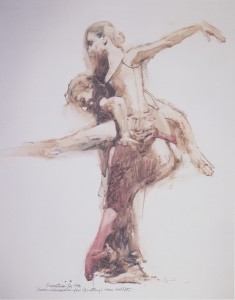
Study from the dance house – See Offset Lithographic Editions
Robert Heindel
The collection was greeted with public and critical acclaim when it was unveiled in Cork Street, London. One particular observer and critic, a former dancer himself, wrote;
…while loosing none of the dip and sway of the dance; Heindel’s painting has entered a new, weightier phase. Like any works of art, his pictures are sonorous with intelligence, the truth as he sees it and life’s beautiful and frustrating contradictions. Thankfully, he makes no attempt to solve them for us, he just provokes the question. And stirs in one observer at least, half-forgotten memories of a previous life.
Jeffery Taylor – Critic
The chance discovery of ‘Still Life’ brought with it the awareness of the choreography and ballets of David Bintley. Thus when Bintley approached Heindel with the request to design set and costumes for a new ballet entitled ‘The Dance House’ the artist took little time to accept. ‘The Dance House’ was to be loosely based around a medieval woodcut. Heindel visualised striking costumes as well as a series of conceptual and literal sets in response to the final line of the woodcut,’Ye all must to the Dance House go’ in order to realise Bintley’s wish to make the performance a celebration of life and death.
Just as with ‘The Garden of Eros’ so ‘Dance House’ gave Heindel the chance to be part of the making of a ballet and, with the Bintley piece, a perfect opportunity to sketch and paint dancers in costumes he had designed against the set he envisaged.
Originally commissioned for San Francisco Ballet, the collection of paintings after the ballet were exhibited in 1995 at the iconic Frank Lloyd Wright building (Circle Gallery) in San Francisco.
Whilst the desire to paint figures continued to the end of his life, during the mid 1990’s Heindel found a need to experiment with shape, form and colour as he had never before. This complete departure from dance was conveniently tagged ‘Painted Walls’. Whilst the first of these panels did indeed resemble the work found in parts of east and west Africa as domestic wall decoration, the concept evolved and results resembled avant-garde stage backdrops, others appeared pure abstract and eventually as immediate response to personal or world events.
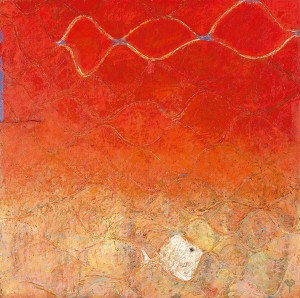
Painted Wall #9 – See Silkscreen Editions
‘Painted Walls started out as a real indulgence, I just had the need to create something for myself in a totally new way, the enjoyment turned to captivation. I realise I’m outpouring my conscious and sub-conscious thoughts with these walls. They seize my energies, I have no preconceived idea of their physical destiny, all I can say is I simply paint them for my own sake’
Robert Heindel
The ‘Painted Wall’ series was a theme the artist returned to throughout the rest of his life, they often served as a diversion from the dance or indeed a reorientation. What is certain is the fact that elements of the wall series appeared in subsequent dance pieces where a dancer or dancers were set against dark fields of abstract form or colourful elements, incredible horizons or dark foreboding chasms.
In a broad period that spanned 1995 to 2005, two definite sources are evident; The Ballets of David Bintley and Japanese Dance of both contemporary and classic style.
The friendship that Heindel enjoyed of Bintley, developed from the earlier experiences of ‘Still Life’ and ‘The Dance House’ resulted in an almost free and open access to everything Bintley was involved with. This of course meant new works as well as then existing ballets. ‘Carmina Burana’ ‘The Protecting Veil’ both featured in important bodies of work. ‘Arthur’ was also commissioned by Birmingham Royal Ballet, and choreographed by David Bintley. Part I (Arthur Pendragon) and Part II (Le Mort d’Arthur) are both full-length ballets, and have occasionally been performed in one day, Part I in the afternoon and Part II in the evening. For Heindel, the chance to be at the beginning of the interpretation of this legend was, in his own words ‘just perfect’.
‘Towards the end of his creative life Bob painted a series based upon my epic ballet ‘Arthur’. It represents the largest body of work he ever devoted to one piece and, in my opinion, is the most disconcerting and enigmatic collection of pictures he ever produced.’ David Bintley
(Director, Birmingham Royal Ballet. 1985 – )
As for Japanese Ballet, the introductions he enjoyed in Japan once again gave him the kind of access that he so relished, the anguish and frustrations of rehearsal, the reality of illusion and the making of a performance from an idea to curtain call. Two projects in particular were the focus of subsequent exhibitions; ‘Junction’ and H. Art Chaos. ‘Junction’ allowed him to follow dancer Sobi Sasaki as she worked with the choreographer Toru Shimazaki and composer Taro Hakase in the development of a dynamic modern piece which was premiered in Tokyo.

Study for Floating Angel #10 – See Offset Lithographic Editions

Study for Floating Angel #11 – See Offset Lithographic Editions
H. Art Chaos, an all female modern troupe caught Heindel’s imagination with their virtuosic dancing, narrative structure, and daring barrel rolls, back flips and extended balances. In particular their piece ‘Secret Club – Floating Angels 2000’, which he saw in both Tokyo and New York, took his imagination. The silver stage upon which Angels was performed, the cue for the silver wings within the completed works – the energetic and daring paintings are in complete contrast to the precision and realism of those from Covent Garden some two decades prior.
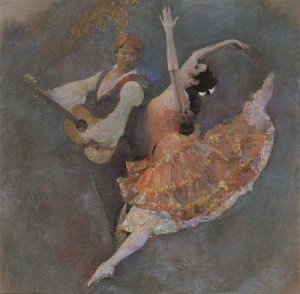
Carmen – We are able to exhibit for sale original works from Private Collections and The Estate of Robert Heindel.
And thus, as David Bintley is often quoted, that Robert Heindel was the ‘greatest painter of Dance since Degas’ so the images upon our site provide the evidence to substantiate his claim. What is certain is the fact that Heindel has left a record of dance in its many forms as created, rehearsed and performed in the late twentieth and early twenty-first centuries, surely in time this extensive and, for this writer, exciting body of work, will serve as both a visual and academic reference for future lovers of dance and art.
© Copyright Colin Rawlings

